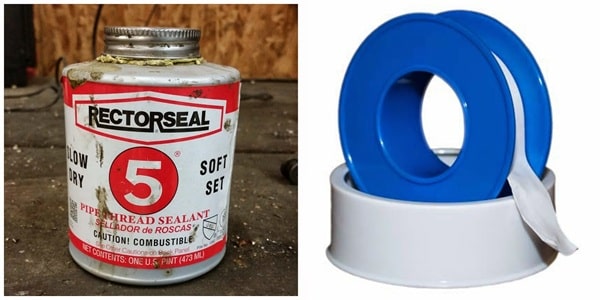When it comes to sealing threaded pipe connections, two products dominate the toolbox: Teflon tape and pipe dope. Both serve the same basic purpose—preventing leaks—but they do so in very different ways. If you’re working on a plumbing project and wondering which one to use, this guide will help you decide by breaking down the pros, cons, and best-use scenarios for each.
What Is Teflon Tape?
Also known as PTFE (polytetrafluoroethylene) tape or plumber’s tape, Teflon tape is a thin, white (or sometimes colored) tape that’s wrapped around male pipe threads before connection. It’s made from a synthetic fluoropolymer known for its low friction and excellent resistance to heat and chemicals.
Pros of Teflon Tape
-
Clean and easy to use: No mess, no cleanup—just wrap and go.
-
Effective sealing: Creates a tight seal on threaded joints, especially in water and air systems.
-
Non-hardening: Teflon tape doesn’t dry out or harden, which means it’s easier to disassemble the joint later if needed.
-
Cost-effective: A roll costs just a few dollars and lasts for many applications.
Cons of Teflon Tape
-
Technique matters: If you wrap it incorrectly or not enough, it can lead to leaks.
-
Not ideal for all materials: Overuse or incorrect application on plastic threads can cause splitting or overtightening.
-
Limited sealing strength: For high-pressure or heavy-duty applications, Teflon tape may not offer enough sealing power alone.
What Is Pipe Dope?
Pipe dope, also called pipe joint compound, is a thick, paste-like material applied with a brush or squeeze tube to male threads before tightening. It’s been used in plumbing for decades and is known for providing a strong, long-lasting seal.
Pros of Pipe Dope
-
Stronger seal: Provides a durable, pressure-resistant seal, especially useful for metal-to-metal connections.
-
Great for large pipes: Ideal for connections over ½” where tape may not offer sufficient coverage.
-
Lubricates threads: Makes assembly smoother and reduces the chance of cross-threading.
-
Variety of formulas: You can find pipe dope that’s rated for gas, high temperatures, or specific plumbing systems.
Cons of Pipe Dope
-
Messy: Can get on your hands, tools, and surrounding surfaces.
-
Takes more time: Application and cleanup are slower compared to tape.
-
Some compounds harden: Not all formulas stay soft; hardened compounds can make disassembly difficult or even damage threads.
When to Use Teflon Tape
Teflon tape is best used in these situations:
-
Small-diameter pipe connections (½” or less)
-
Low-pressure water systems
-
DIY home repairs
-
Compressed air lines
-
Plastic fittings (when applied carefully and not overtightened)
It’s especially popular for faucet replacements, showerhead installations, and quick fixes where speed and cleanliness are important.
Pro Tip:
Wrap the tape in the direction of the threads—usually clockwise—starting at the end and overlapping each wrap by about half. Three to four wraps are typically enough.
When to Use Pipe Dope
Pipe joint compound is often the better choice for:
-
Metal-to-metal connections
-
Gas lines (natural gas or propane)
-
High-pressure or high-heat applications
-
Large-diameter pipes
-
Permanent installations
For example, when installing a water heater or a natural gas appliance, many pros prefer pipe dope for its strength and reliability. Just be sure to use a compound rated for the specific type of gas or fluid being used.
Pro Tip:
Apply a thin, even layer of pipe dope around the male threads only. Avoid applying it to the first thread to prevent it from getting into the pipe interior.
Can You Use Both?
Yes—and sometimes, it’s the best approach.
Some plumbers use Teflon tape followed by a thin coat of pipe dope for extra sealing power, especially on gas lines or older threaded connections that may not be perfect. Just make sure the pipe dope you choose is compatible with PTFE and won’t cause it to break down over time.
However, avoid using both on plastic threads, as the combination may create too much lubrication, increasing the risk of overtightening and cracking.
Which One Should You Choose?
Here’s a quick decision guide:
| Application | Best Choice |
|---|---|
| Water supply lines | Teflon tape or pipe dope |
| Gas lines | Pipe dope (approved for gas) or both |
| Metal fittings | Pipe dope |
| Plastic fittings | Teflon tape |
| Compressed air systems | Teflon tape |
| High-pressure systems | Pipe dope |
| Large diameter pipes | Pipe dope |
| Quick fixes or DIY repairs | Teflon tape |
Final Thoughts
Both Teflon tape and pipe dope are valuable tools in a plumber’s toolkit, and neither is “better” in all situations. Choosing the right one comes down to the type of connection, the material, and the demands of the system. For small, quick repairs, Teflon tape is often enough. But when strength, durability, and pressure resistance are key, pipe dope takes the win.
If you’re a DIYer, keep both on hand—you’ll likely run into projects where one works better than the other. Used correctly, either product can help you achieve leak-free, long-lasting plumbing connections.


